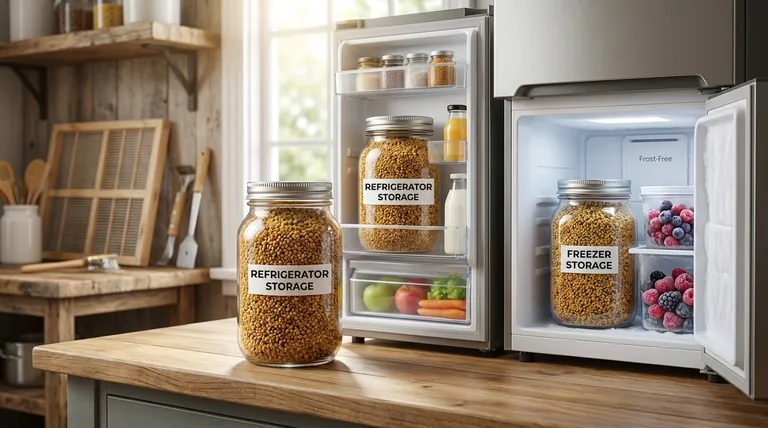To properly store bee pollen, you should keep it in an airtight container in the refrigerator for up to one year or in the freezer for one to two years. Freezing is the superior method as it best preserves the pollen's delicate nutritional profile, and while it can remain safe indefinitely, its peak potency is maintained within this two-year window.
The central takeaway is that bee pollen is a perishable, biologically active food. Its shelf life and nutritional value are directly determined by storage temperature, with freezing being the gold standard for preserving its freshness and health benefits long-term.

Why Proper Storage is Critical for Bee Pollen
Bee pollen is not a dry, inert powder like a typical spice. It is a collection of flower pollen, nectar, and bee saliva, making it rich in sensitive enzymes, vitamins, and nutrients.
The Impact of Heat and Light
Exposure to heat, light, and oxygen are the primary enemies of bee pollen's nutritional integrity. These elements rapidly degrade its beneficial compounds, diminishing the very reason for its consumption.
Preserving Nutritional Potency
Proper storage, particularly freezing, effectively halts this degradation process. It locks in the freshness and preserves the delicate enzymes and vitamins that make bee pollen a valued superfood.
Comparing Storage Methods: Freezer vs. Refrigerator
Your choice between freezing and refrigeration depends entirely on how quickly you plan to consume the pollen.
Freezing: The Gold Standard for Preservation
Freezing is the most effective method for long-term storage. It maintains the nutritional value and freshness by keeping the pollen granules in a state of suspended animation.
Place the bee pollen in an airtight container to protect it from moisture and freezer burn. This prevents the granules from clumping and preserves their quality.
Refrigeration: A Viable Short-Term Option
If you plan to use your bee pollen supply within a few months to a year, refrigeration is a perfectly acceptable method.
As with freezing, an airtight container is crucial to protect it from moisture and absorbing other odors from within the refrigerator.
Room Temperature: Not Recommended
Storing bee pollen at room temperature is strongly discouraged. The ambient warmth and light will quickly degrade its nutritional content and can create an environment for potential spoilage.
Understanding the Trade-offs and Best Practices
Simply putting your pollen in the cold is not enough. How you handle it is just as important.
The Real Issue: Quality vs. Safety
Some sources state pollen can be frozen "indefinitely." While it may remain safe to eat for a very long time, its nutritional potency declines. The one-to-two-year guideline is for ensuring you get the maximum health benefit, not just food safety.
The Enemy is Moisture and Air
The single most important factor beyond temperature is using a truly airtight container. Glass jars with tight-fitting lids are ideal. This prevents moisture from causing clumping and protects against oxidation.
Handling and Daily Use
To prevent degradation from temperature fluctuations, avoid taking the entire container out of the freezer for each use. Instead, keep a small weekly supply in the refrigerator and refill it from your main frozen stock.
How to Store Your Bee Pollen for Maximum Potency
Your storage strategy should align directly with your purchasing and consumption habits.
- If your primary focus is daily or weekly use: Storing your bee pollen in an airtight container in the refrigerator is sufficient and convenient.
- If your primary focus is long-term preservation after buying in bulk: Freezing the pollen in an airtight container is the only method that ensures its potency over many months or years.
Ultimately, treating bee pollen as the fresh, perishable food it is ensures you receive the full nutritional benefit it has to offer.
Summary Table:
| Storage Method | Recommended Duration | Key Consideration |
|---|---|---|
| Freezer | 1 to 2 years (peak potency) | Best for long-term preservation; use airtight container. |
| Refrigerator | Up to 1 year | Ideal for short-term use; protect from moisture and odors. |
| Room Temperature | Not recommended | Rapid degradation of nutritional value. |
Stock up on fresh, high-quality bee pollen with confidence! As a trusted supplier for commercial apiaries and distributors, HONESTBEE provides beekeeping supplies and equipment designed to support your operations from harvest to storage. Ensure your products maintain their peak nutritional value—contact our experts today to discuss your wholesale needs and discover how we can help you deliver superior quality to your customers.
Visual Guide

Related Products
- Wooden Queen Bee Excluder for Beekeeping
- Professional Galvanized Hive Strap with Secure Locking Buckle for Beekeeping
- Versatile Ratchet Hive Strap with S-Hooks for Secure Fastening
- Stainless Steel Honey Press Wax Press with Tank
- Electric Flatting and Embossing Machine with Tray for Beekeeping
People Also Ask
- What makes polyurethane foam environmentally friendly? The Surprising Benefits of a Durable, Inert Material
- What are the advantages of using a queen excluder? Boost Honey Harvest Efficiency & Hive Control
- Should queen excluders be used in Flow hives? A Critical Guide for a Clean Harvest
- What are the advantages of using excluders in terms of wax recovery? Maximize Your Yield of Premium Beeswax
- What are the disadvantages of using a queen excluder? A Guide to Hive Health & Productivity



















